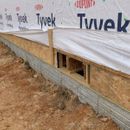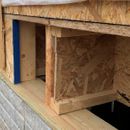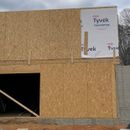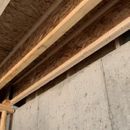Sealing/Insulating Rim Joists and Sill Plate Area
Getting my first home built by a contractor–he’s supposed to be good and I do trust him… BUT… there are some areas pertaining to air sealing that he is just going to do standard practice on, meeting code. But I’d really like to go above and beyond. So wanted some other insight on this, (because I’m sure he’ll just tell me “what we do works just fine”). I’m new to all this so if I get any lingo wrong feel free to correct me haha.
The area where the sill plate meets basement foundation and rim joist/floor joist area has got plenty of gaps and cracks along it. Everything is being done pretty standard, sill sealer under PT plate and rim joist/floor joist assembly I think is just pretty standard. Tyvec weather barrier on exterior. I believe they’ll just be doing some bat insulation inside the rim joist in basement.
I’ve included some photos. The one picture shows an area of rim joist that hasn’t been installed yet, so you can get an idea of the cross section.
I’d really like to make this area more air-tight and less prone to bugs and such crawling in.
I know there are tons of threads discussing the various aspects of this. But I’ve gotten pretty overwhelmed with info… so wanted to just explain my exact situation and get opinions.
Different methods I am considering doing myself:
1. Peel up Tyvec and caulk all joints from exterior, then tape Tyvec back down. Not sure if just a standard joint sealer/caulk would suffice or if I should use one of these “vapor permeable” sealers like a Prosoco or Poly-Wall Blue Barrier products or 475 Visconn.
2. Do all of method 1 but from the inside. Caulk as best I can, maybe use some Great Stuff in some areas. Then have insulation guy insulate on top of that. Main issue with this is there are a couple lengths of wall where the Floor Joist runs right close parallel to Rim Joist and I can’t access this area very easily (shown in pic).
3. Have the entire interior of Rim Joists spray foamed professionally. I assume they could get into these hard to access areas with their equipment.
Would really appreciate some opinions on this! Thank you!
GBA Detail Library
A collection of one thousand construction details organized by climate and house part














Replies
goatmig,
Where is your primary air-barrier? The sheathing? An interior membrane?
Well that would be the Tyvec on the exterior (I think).
goatmig,
Knowing where and what it is, and how to maintain its continuity around the building envelope is really important for both you and your builder. I don't want to sound discouraging but that is best done at the design stage. Deciding how to air-seal a certain area isn't something you can do by just looking at it. I would press pause until you have worked out what strategy you want to use and then get back to how you will deal with the rim joist.
Unfortunately house-wrap makes a very poor air-barrier, and is hard to transition from the walls to whatever you are using on the ceiling. The two most common ones are taping and sealing the sheathing, and installing an interior membrane under the drywall. Reading the articles on air-sealing here on GBA is time well spent.
Thanks. You’re right I gotta speak with him and make sure we are on the same page… or on a page, on what this process is.
If his answer is “primary air barrier is on exterior, it’s the Tyvec” I’m probably gonna have to work with that. Is it okay to do some mix and match with methods, Tyvec across wall then a liquid flashing around important transitions. Sort of like the Option 1 I laid out?
goatmig,
If it is the Tyvek, your primary problem will be how continuity is maintained when it transitions to whatever you are using on the ceiling. If the base of the house-wrap is taped to the concrete foundation and the perimeter, and all penetrations (windows, doors, pipes, vents, etc.) are sealed with liquid flashing or tape, then you don't need to worry about sealing the sill-plate behind.
Using batt insulation against the inside of the rim-joist only works if you have an well sealed interior air-barrier to stop moist air from moving through it. Most people use foam board instead.
Malcolm,
Thanks. Should liquid flashing used around these areas be a vapor permeable product like Prosoco, Blue Barrier, etc?
Deleted
I am in a similar boat.. My air barrier strategy is following.
Build a box with ZIP completely enclosing this house. Like a cube including zip on top of ceiling joists. Ceil all areas. have roof rafters on top of ZIP. ZiP is the primary water & air barrier.
Spray foam the RIM joists as suspenders.
Check pictures.. hope it helps.
What are you using as your vapor retarder layer?
Most probably some smart vapor retarder.. like certainteed membrane
Is that the decision to add that into your interior based on your Climate zone?